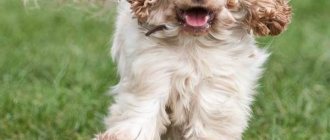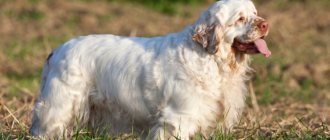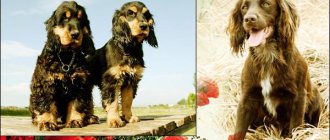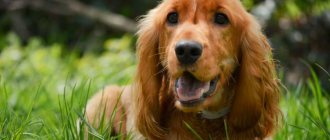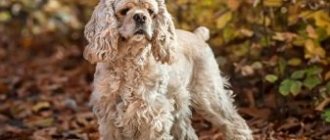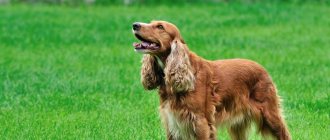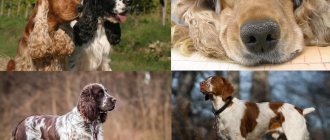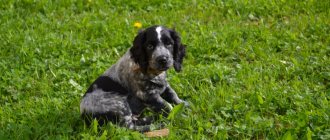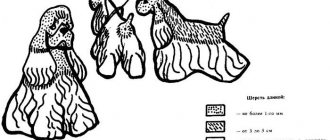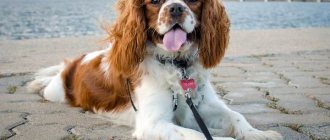History of the American Cocker Spaniel breed
American Cocker Spaniel
It is believed that the ancestors of the American Cocker Spaniel emigrated to the New World from England along with the first settlers. For several centuries, animals roamed freely across the continent, until professional breeders noticed them at the end of the 19th century. Well, then, as usual: experimental matings, selection of the most successful individuals in terms of exterior design - and now, at the New Hampshire Dog Show of 1883, the first cocker of the American breed shines. The specimen presented by the breeders was noticeably smaller and shaggier than its European counterpart - the English Cocker Spaniel, but at the same time retained most of its hunting qualities.
In 1921, “Americans” developed their own standard of appearance, and in 1946, overseas spaniels finally separated from their ancestors from Foggy Albion, becoming an independent breed. Cockers “made in USA” appeared in Russia in the 70s, but at first they did not arouse much interest among either specialists or amateurs. The demand for frisky shaggy dogs began to grow only in the late 80s, with the advent of breeding nurseries in the USSR that were in charge of breeding and selling American cockers.
Key facts
Smart, cute - whatever they call these little dogs bred for hunting. The American Cocker Spaniel, the closest relative of the English one, is rightfully considered one of the best helpers in baiting medium and small game. Appearing in the United States of America, the pet has become widespread throughout the world. You can often hear other abbreviated names: American cocker or cocker.
Despite its miniature size, the breed has gained high popularity among game shooting enthusiasts. The American Cocker Spaniel's light weight (up to 14 kg), as well as its height (up to 39 cm), allows the pet to penetrate into places inaccessible to others in order to please the owner with a trophy.
The lifespan of the American Cocker Spaniel is 13-14 years. During all this time, the dog remains active and very cheerful. According to reviews from owners, dogs are very vulnerable and take offense for a long time at shouts or dissatisfied intonation from a person. The characteristics of the American Cocker Spaniel breed claim that they love their owner and consider them the main thing, and are ready to go on the most incredible walk.
An eccentric and active pet becomes easy to control and flexible with proper upbringing. It is important not to ignore his pranks and be sure to stop his self-indulgence. You shouldn't leave a cocker alone for a long time. The description of the American Cocker Spaniel breed emphasizes that these handsome dogs have difficulty withstanding loneliness. They are equally comfortable living in a private, country house or apartment, because they do not need a lot of space.
Pets should be walked 2-3 times a day, and long and active walks in the fresh air are desirable. Because of this, cockers may not be good companions for older people, but are excellent for sporting owners or hunters.
Appearance of the American Cocker Spaniel
American Cocker Spaniel Puppy
American Cocker Spaniels are the smallest hunters among their “colleagues” in the gun group. They are not much smaller than English cockers (average height - 34.3-34.9 cm), but their muzzles are much shorter. Among other things, the “Americans” have a more glamorous appearance, which they owe to their satiny coat. However, the dogs had to pay for this beauty with a hunting instinct, which in them manifests itself in a somewhat muted form. As for the weight of American cocker spaniels, most cynological associations turn a blind eye to this parameter. Both eight- and fifteen-kilogram individuals are capable of winning the championship title.
Head
American Cocker Spaniels have a moderately rounded skull with pronounced brow ridges, infraorbital part and stop. The muzzle of dogs is wide, of sufficient depth, turning into flat cheekbones. The standard muzzle is square in shape with a pronounced vertical edge.
Ears
Long, blade-shaped, covered with abundant fur. The ear material is thin but dense.
Nose
The lobe is medium in size with well-opened nostrils, allowing the dog to catch even the faintest odors. The color of the nose matches the shade of the “American” eyelids. So, animals of black and tan, black, and black and white colors have a black lobe. Individuals with lighter coats have a brown nose.
Jaws and teeth
Overgrown American Cocker Spaniel
The shape of the American Cocker Spaniel's jaws is close to square. Dogs of this breed have strong, medium-sized teeth with a scissor bite.
Eyes
Round almond-shaped, normally set, without convexity. The color of the iris should be a rich dark color. Most often it is dark brown.
Neck
Long, gracefully curved, gradually tapering towards the head. It bends easily, which allows the animal to bow its head low and touch the ground with its nose.
American Cocker Spaniel muzzle
Frame
Running American Cocker Spaniel
Compact body with a strong, sloping back and a deep and moderately broad chest.
Limbs
Both the front and hind legs of the American Cocker Spaniel are muscular and have good mobility. The shoulder blades of representatives of this breed are quite developed and strongly retracted, which makes their movements freer and faster. A good push in running is provided to the animal by massive hips, strong knees with normal articulation angles, and low hocks. The paws of the “Americans” are large, but compactly assembled, with elastic pads.
Tail
The tail of American Cocker Spaniels is required to be docked. It is usually held at the level of the back or slightly raised, but never takes a vertical position and is not tucked in. A tail hidden between the hind legs indicates the dog is timid and insecure.
Wool
The coat is soft, silky, straight or slightly wavy with abundant, dense undercoat. The part of the body with the shortest hair is the dog's head. On the body, legs and ears the hair is longer and thicker.
Color
American Cockers can be black, black and tan, or mixed (white combined with some other shade) colors. In addition, all types of monocolors are acceptable for this breed: from light fawn to brown (solid or with tan). As for tan marks, they must be located in the parts of the body specified by the standard. These are usually the areas above the eyes, cheekbones, inside of the ears, legs, chest and area under the tail.
White American Cocker Spaniel with brown markings
American Cocker Spaniel black and tan
Disqualifying faults
The most common reasons for disqualification are insufficient/excessive height (deviation from the standard by more than 1.5 cm), atypical colors, and non-standard arrangement of tan marks. For example, American Cocker Spaniels with white spots in any part of the body except the throat and chest, as well as with tan occupying more than 10% of the area of the main color, will be excluded from participation in competitions at the selection stage. Dogs with behavioral disorders who exhibit excessive aggression, cowardice, or nervousness will suffer the same fate.
Decorative (mini)
Cavalier King Charles
Cavalier King Charles Spaniels
They were in great demand as boudoir dogs back in the 15th and 16th centuries, but the breed’s heyday came in the second half of the 17th century and is associated with the reign of King Charles II Stuart in England, from whom they got their name.
In the old days, Cavalier King Charles had another purpose - they were used as living heating pads, protecting their owners from the piercing cold in the premises of ancient castles or while traveling in carriages.
Currently popular as pets and show dogs. They are elegant, graceful and have a playful and affectionate disposition. At the same time, they are brave, agile and energetic.
Weight ranges from 5.4 to 8 kg, their fur is quite soft and long. There are three acceptable colors for Cavalier King Charles: black and tan, ruby, Blenheim (reddish-white or white-fawn) and tricolor.
King Charles
King Charles Spaniels
The eyes are large, expressive, widely spaced. Colors can be black and tan, ruby, Blenheim or tri-color.
King Charles Spaniels are great as lap dogs, but when kept in an apartment, they require regular walks.
Continental Toy
A small dog whose height is approximately 28 cm and weight 1.5-5 kg.
The head is medium-sized, with a convex skull and a sharp transition to an elongated, slightly pointed muzzle.
The ears are set above the eye line and can be erect, covered with a beautiful fringe, or hanging.
Depending on the position of the ears, continental toy spaniels are divided into two varieties:
- Papillon (with erect ears).
- Phalen (his ears droop).
IMPORTANT! These dogs are distinguished by their active, mischievous and playful disposition; they love outdoor games and are incredibly loyal to their owners.
Tibetan
Bred in the Buddhist monasteries of Tibet, Tibetan spaniels are not related to European spaniels. Their original purpose was to warn the monks about the approach of strangers, in addition, they turned prayer mills.
Apparently, they came to Europe during the Middle Ages.
Tibetan spaniels are small, fluffy dogs that resemble Pekingese dogs. Their height at the withers is 24-26 cm, and their weight is from 4 to 6 kg. The head is medium-sized, with a slightly convex skull and a slightly flattened muzzle.
The eyes are oval, dark and expressive. The ears are small, set high, the tail is thrown over the back and resembles a fan.
The coat is short on the muzzle and on the front sides of the limbs, somewhat elongated on the body, with a thick and thin undercoat. There are featherings on the ears, tail and back of the limbs.
Any colors are allowed, but the most valuable are considered dark ones with a small white spot on the chest, which in Tibet is considered a sign of a pure heart.
Japanese Chin
Japanese Chin
They are distinguished by their medium size (height in males is up to 25 cm, in females slightly lower, weight - 1.8-3.2 kg).
The body format is square, the head is rounded and quite wide, with a well-defined stop. The muzzle is shortened and upturned, the nose is located approximately at eye level. The ears are hanging, triangular, covered with silky long hair.
The tail, carried over the back, is also profusely pubescent.
The coat is straight, silky and long, the undercoat is poorly developed. The color is white and black or white and red.
The Japanese Chin is an intelligent, proud, but at the same time friendly and balanced dog, distinguished by a special, delicate manner of communicating with its owners.
Photo of an American Cocker Spaniel
Character of the American Cocker Spaniel
The American Cocker Spaniel is an affectionate fidget, ready to follow its owner to the ends of the earth. These long-eared “hairies” have no problem finding a common language with cats and other dogs, not to mention the owner, who is a being of a higher order for the animal. But American cockers do not get along with representatives of the feathered family, periodically encroaching on their life and health (the hunting instincts of their English ancestors affect them). If your pet has not completed the training course and you are not confident in its endurance, it is better to let parrots and other birds out of the cage in its presence.
American Cocker Spaniel puppy with kitten
In relationships with children, American Cocker Spaniels are quite friendly, but, alas, they do not always control themselves. Carried away by chasing and fighting, dogs can attack babies, slightly biting them. In general, “Americans” are characterized by a certain infantilism of character. As the breeders themselves say, this is one of the few hunting breeds whose representatives, even at a very advanced age, retain puppy habits.
American cockers are hyperactive, emotional and so dependent on human society that this sometimes turns into manic attachment. However, despite the successful exploitation of the image of naive simpletons, these glamorous handsome men are not short of cunning, and to be convinced of this, the owner just needs to give up and stop raising his ward. Having felt freedom, the cocker will very quickly turn into a charming, but completely uncontrollable hooligan who does not recognize any restrictions.
The American Cocker Spaniel is not a breed for careerists and workaholics who spend days at work. Loneliness is a burden and not beneficial for dogs, especially since the eccentric temperament of animals requires a regular release of energy, which a busy owner simply cannot provide. When you lock up your pet and go to work, do not be outraged if upon your return you find that your four-legged friend was entertaining himself as best he could, gnawing on shoes and tearing wallpaper off the walls.
Who looks like a rabbit here?
Mating
Individuals mature by the age of one and a half years, but it is recommended to breed bitches only during the 3rd heat, since before that the dog’s body is not strong enough and developed enough to fully bear offspring.
Pustules in females occur 2 times a year, with an interval of 6 months. Fertilization is possible only during the period of ovulation, which occurs on the 8th day after the onset of estrus. At this time, certain signs appear:
- The female becomes playful;
- The discharge from the loop is red and profuse;
- If you touch the base of the tail, the bitch begins to raise her rear and tail.
The peculiarity of mating cockers is that this process requires the control of experienced breeders or dog handlers. Often among the representatives of the breed there are overly active individuals that can injure their partner during mating. It is recommended to carry out additional, safety knitting.
The fertility of bitches is not related to the fertility of the male, the quality of his seminal fluid and the number of matings and depends on heredity.
Education and training
Even if you are indifferent to handling and do not intend to take your pet hunting, it is still necessary to raise it and teach it commands, if only for the sake of your own comfort and peace of mind. An American Cocker Spaniel that is poorly socialized and does not obey basic rules of behavior is a lawless dog. Representatives of this breed are easy to train, but due to their natural restlessness, they better absorb educational material if it is presented in a playful way. The method of positive reinforcement will also not be superfluous - not a single “American” can resist a mouth-watering treat.
American cocker spaniel on a leash
It is necessary to begin education with elementary commands like “No!” and “Sit!” From the first weeks of being in the house, the puppy should be able to recognize its own nickname, as well as understand the meaning of the command “Place!” Don't be lazy to accustom your animal to your hands. The dog should not shy away from your touch or panic from being lifted. And of course, no psychological or, even worse, physical violence against your pet! American cockers are dogs with a gentle psyche; they have absolutely no need for unnecessary phobias.
Despite the fact that FCI classifies American Cocker Spaniels as gun dogs, in its homeland the breed is better known as a sporting dog. In the USA, cockers are regular participants in all kinds of dog shows and agility competitions, so if you are planning a show career for your pet, take a ring training course with him and teach him the correct stance. For example, to develop correct posture, it is useful to walk the dog on the so-called “ring”, which is a short ribbon, the ends of which are closed in loops. This type of leash allows you to pull up the animal’s head, fixing it in a slightly raised position. This accessory, which is unpleasant for a dog, must be used very carefully and in doses. An “American” should not have the impression that he is being pushed around. The American Cocker Spaniel is taught to walk around the ring on command using treats. At first, the animal follows the owner to grab a treat from his hands, but subsequently gets used to doing without it, reacting only to the command “Come to me!”
Helpful advice: If an American Cocker Spaniel becomes overly emotional and bites you or other family members during training, it must be stopped. Give your pet a favorite toy or distract him with a treat. Dogs that are too distracted by their own attacks and have fallen out of touch with reality are not prohibited from being lightly spanked.
American cocker spaniel light fawn color
Useful video
From the video you will learn everything about the Cocker Spaniel dog breed:
Loading…
Dwarf spaniels are now practically not used for hunting and have simply become pets.
Like their larger relatives, they have a well-proportioned build, a small, beautiful head, a soft, silky coat and long ears, giving them a typical spaniel appearance.
Their look is friendly and gentle, and their eyes are large and expressive.
These dogs have an affectionate and good-natured disposition and make wonderful pets.
Hunting with an American Cocker Spaniel
Despite the fact that, theoretically, American Cocker Spaniels are capable of working with a feather, they are rarely seen in this role. In Europe, representatives of this breed are not used in hunting at all, preferring the more obedient and focused English cockers. And yet, training a pet to search for a bird is quite a feasible task. It is better to start classes from an early age. First, the owner simply brings the game home and lets the dog smell it - this is how the animal gets acquainted with the smell of future prey. Gradually, lessons are transferred to the natural environment, for example, to the forest or fields.
A properly trained cocker spaniel should not only look for shot game and make a stand, but also show restraint, patiently waiting for the owner to arrive. However, many “Americans” are not able to concentrate on one object for too long and switch to other external stimuli such as butterflies and lizards. An ultrasonic whistle (Galton whistle), which can be used not only in the field, but also on the training ground, helps to partially solve the problem and set the pet up for work.
Kinds
There are more than 20 varieties of spaniels. Each of them has a different appearance and character. But the dogs of this group have one purpose - hunting small and medium game. The closest relative of the representative of the breed in question is the English Cocker Spaniel. These two brothers differ, firstly, in their physique parameters, and secondly, in their disposition.
The “Englishman” is more stable in behavior and mood, while the “American” is eccentric and fickle. In addition, the first is more gentle, and the second is rather independent and serious. The American Cocker is an ideal show pet. He is diligent, calm and gentle. Loves to be the center of attention, very artistic.
Care and maintenance
Since the American Cocker Spaniel is more of a decorative companion than a hunter, its main habitat remains a house or apartment. The animal is taken outside mainly to the toilet or for a walk and only after vaccination. In addition, for the first six months the puppy is not allowed to go down stairs on his own, so as not to deteriorate the position of the limbs.
Running American Cocker Spaniel
You should start caring for your dog by equipping it with a separate corner with a bed, toys, bowls for food and water. It is necessary to place the puppy's bedding or basket in the quietest place in the apartment, where drafts do not reach and where it is not too hot (a place near a heating radiator is frankly a bad option). In the first days, the American Cocker Spaniel will, of course, try to ignore your efforts and lie down in some more comfortable place, for example, on the sofa, so you need to keep an eye on him. Under no circumstances indulge your baby’s whims and do not take him to bed with you, no matter how much he wishes, otherwise in the future this cunning handsome fellow will sit on your neck.
American Cocker Spaniels love to go for walks, so they need to be taken outside two, or preferably three, times a day. During your walk, allow your dog to warm up properly by running a race with him. At the same time, you can practice maintaining correct posture. To do this, let your pet walking on a leash pull you forward (you can learn the command “Pull!”). But it is better to minimize communication with other dogs, especially homeless ones, since cocker spaniels are very susceptible to various types of infections.
American Cocker Spaniel black and tan
Hygiene
The American Cocker Spaniel is not a breed for the lazy. Of course, you can take your pet to a grooming salon several times a week, where a specialist will work on him while you flip through magazines and sip coffee. But in this case, keeping a dog will result in a significant amount for the budget. If such expenses do not suit you, learn to care for the fur of your four-legged friend at home.
Well-groomed beauty
The first thing you need to do is get a slicker brush, brushes, combs and a tangle cutter, because you will have to comb the satin hair of your American Cocker Spaniel every day. And don’t be fooled by the fact that puppies have thinner hair. This will pass with age. In general, the brushing procedure itself is extremely tiring for dogs, so the sooner you get your puppy used to it, the better for you.
No matter how well-behaved your dog is, during walks he will still get his “fur coat” dirty to one degree or another, picking up debris and road dust on it. American Cockers should be washed more often than other decorative breeds: on average once every two weeks. For bathing, it is better to choose sets of pet shampoo and rinse designed for long-haired dogs. After washing, to make combing easier, it is recommended to rinse your pet’s fur in a weakly concentrated solution of acetic acid (can be replaced with citric acid). This will give the hair a noble shine and protect the animal’s skin from parasites.
The coat of American Cocker Spaniels often becomes matted, and this does not depend on the quality of care for the dog. The areas most susceptible to this phenomenon are the armpits, hocks and groin areas. Before each bath of your dog, arm yourself with a tangle cutter and remove matted areas of hair.
You can't avoid fussing with the long ears of the American Cocker Spaniel. First, during each feeding, they must be lifted and secured with an elastic band above the dog's head so that he does not dip them into the bowl. Secondly, the ear funnels of “Americans” very quickly accumulate wax and dirt, and mites simply love to live in them. Accordingly, examination of the ear canal and cleaning of the ear tissue of representatives of this family must be carried out every few days. You can remove dirt accumulated in the ear by dripping a little warmed vegetable oil inside and wiping the skin with a sponge soaked in hydrogen peroxide or an alcohol solution of boric acid (boric alcohol).
There are fewer problems with the eyes of the American Cocker Spaniel, but in some individuals the eyelid may not tightly cover the eyeball, which is why dust and debris get onto the mucous membrane. In such cases, inflammation is relieved with chilled chamomile infusion or albumin. “Americans” have their teeth brushed 1-2 times a week if the animal eats natural food. For dogs that are drying, the procedure is carried out less frequently, since the solid particles of the food cope quite well with plaque. Some Cocker Spaniel owners offer the dog to chew on a bone instead of standard brushing with a paste. The method, of course, is effective, but it should not be abused, since the teeth of American cockers, gnawing on bones, quickly wear down.
American Cocker Spaniel training
American Cocker Spaniel Grooming
Black American Cocker Spaniel trimmed for show
American cocker spaniels are supposed to be groomed from the age of 1.5-2 months, and if this is done late, the dog will be extremely stressed. For domestic animals that are not aiming for a championship, a hygienic haircut, which is carried out twice a month, will be enough. In this case, the animal’s mats and the area around the anal area are cut off, the hairs in the ear canal are plucked, and the hair on the paws and between the toes is removed to keep them clean. Once every three months or before an exhibition, the animal should be taken to a groomer, who will use a machine to shorten the hair on the face and back of the head, profile the shoulder and chest area, trim the fur on the sides and “ennoble” the paws.
Important: the hair on the back of the American Cocker Spaniel is never trimmed with clippers or scissors. To treat this part of the body, it is best to use a powder brush.
Feeding
Waiting for a tasty morsel
The basis of the dog’s diet should be meat, dairy products, cereal porridges, seasonal vegetables and fruits, as well as sea fish (occasionally and only in the form of fillets). Meat is usually given in the morning, leaving vegetables and dairy products for the evening. Once a week, the cocker spaniel is given a belly festival by treating him to rye crackers (not from the store), egg yolk or dried fruits (raisins, dried apricots, prunes). As for the brain bones, they are best left for puppies that need a lot of calcium. For adult “Americans” this product is no longer so useful. A couple of times a month, the digestive system of the American Cocker Spaniel is “unloaded” by putting a little less than half of the usual daily portion into its bowl.
Nutrition
The diet of any domestic dog should be balanced and complete. This means that in addition to meat and dairy products, she should also eat vegetables, berries, fruits, cereals, etc.
The basic product for a spaniel is raw meat. A young cocker should eat from 100 to 300 grams of this product per day (depending on age). When it is fully formed and grown, you can stop feeding meat, replacing it with super-premium dry fortified food.
In addition, also give your pet: milk, boiled rice/millet/buckwheat/semolina, melons and watermelons, boiled potatoes, cottage cheese, chicken eggs, whole grain bread, bagels, dog biscuits, etc.
List of prohibited products:
- Cream cake.
- Marmalade.
- Chocolate.
- Lard and smoked meat.
- River fish.
- Sharp bones and cartilage.
- Raw pork.
Advice! To keep your pet healthier, give him special vitamins for animals, especially in winter, when his immune defenses are weakened.
Health and Diseases of American Cocker Spaniels
The most common reasons for owners of “Americans” to visit veterinary clinics are food allergies and ear infections, which often lead to complete deafness of the animal. The following ailments are also common among American cockers:
- seborrhea;
- hereditary atopy;
- hepatitis;
- eye diseases;
- epilepsy;
- hip dysplasia.
Handsome Spaniel
Lifespan
The average lifespan of miniature cockers is 13-15 years.
However, dogs of this breed may be susceptible to the following diseases::
- Dysplasia
- Cataract
- Progressive retinal atrophy
- Corneal dystrophy
- Glaucoma
- Hemolytic anemia.
- Allergy
- Otitis and other inflammatory diseases of the ears.
- Dilactation cardiomyopathy.
- Epilepsy
The life expectancy and health status of a pet primarily depends on its heredity and conditions of detention..
How to choose a puppy
First, decide on the class of the animal and sensibly assess your own financial capabilities. Show-category American Cocker Spaniel puppies will cost more not only to purchase, but also to maintain (remember about salon grooming and constant travel to exhibitions). The gender of the dog is also an important selection criterion. Girls are usually softer and friendlier. They quickly get used to their new place of residence and household members, while boys can demonstrate leadership skills. However, if we are talking about buying a bitch with the right to breed, prepare for her behavioral tricks during the period of heat and regular expenses for matings.
Take seriously checking such points as the reputation of the kennel, the pedigree of the puppy and its living conditions. Visually assess the appearance of a potential pet: how well it corresponds to the breed standard. A normally developing American Cocker Spaniel puppy is neat, well-fed and cheerful. He has a cold and wet nose, pink gums and is always clean under his tail. Refuse to buy if they persistently offer you the smallest cocker of the litter. The animal will almost certainly have poor immunity and illness. Babies whose dewclaws have not been removed and their tails have not been docked are also not the most valuable acquisition.
Reviews
Most reviews about the breed are positive; in negative reviews, dog breeders point out how sick their pets are.
- “A very kind plush dog, the life of the party. Not aggressive at all. A little prone to begging. At the same time, a devoted friend who can always cheer you up.”
- “The dog is very kind and obedient, he lived with us for 12 years, during which time there were no problems with him.”
- “A good, but sickly breed... We were warned about diseases of the lungs and ears, but our dog died of a tumor.”
To read: Differences between the Boston Terrier and the French Bulldog in appearance and character
